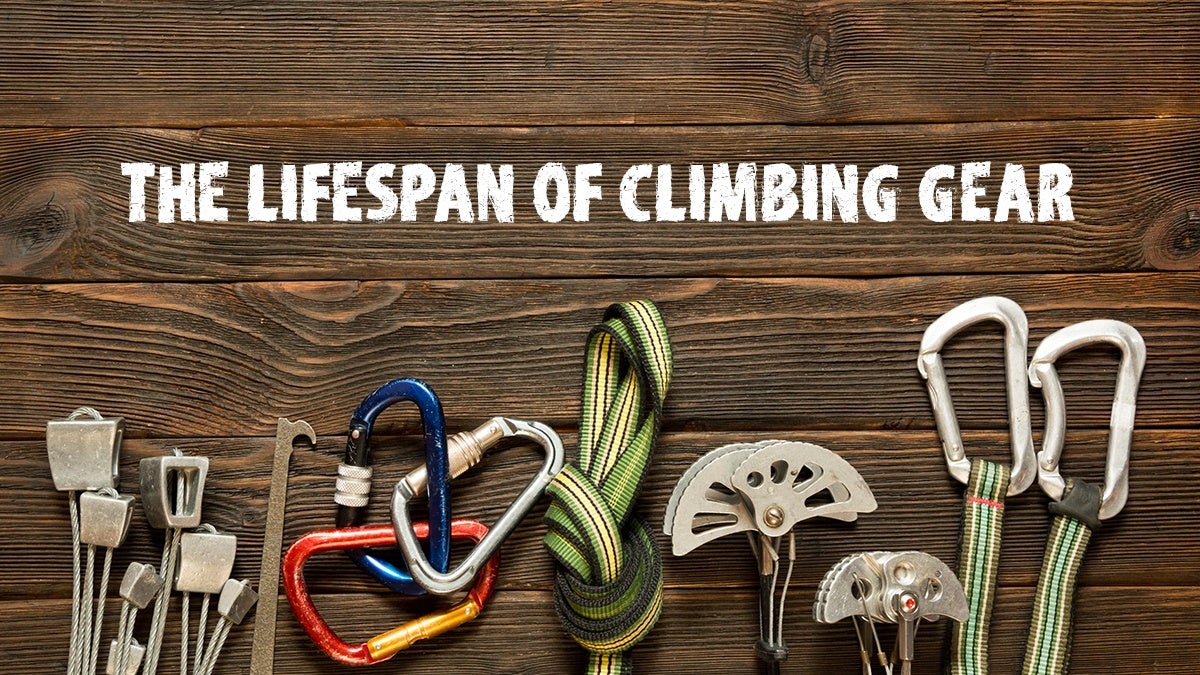The Lifespan of Climbing Gear

All of your climbing gear will need to be replaced eventually, even if you’re not using it regularly. “Soft” equipment, such as ropes, slings, and harnesses will break down much faster than “hard” equipment like your metal carabiners.
It’s important to always play it safe with any piece of climbing equipment. The moment you think that the integrity of your climbing equipment is compromised, it’s time to replace that gear immediately. Never forget that your life depends on your equipment and if a sling, rope, or carabineer fails the results can be catastrophic.
We’re not trying to scare you, rock climbing equipment produced by reputable manufacturers is generally very high quality and reliable. That being said, climbers tend to use equipment for much longer than the manufacturers actually intended.
Below, we’ve listed a few pointers for assessing the quality of your climbing equipment and have provided some general guidelines for when equipment needs to be replaced. When it comes time to replace equipment, accept the loss and throw that piece of equipment away. You should know what climbing gear you should get and if it is safe to buy cheap climbing gear. Spending a few bucks is always worth saving yourself from injury or death.
Tips for Assessing Climbing
Gear Look for Cracks, Tears, or Smooth Spots
If you’re evaluating metal gear, you’re going to want to keep an eye out for any cracks. Small cracks can occur after big falls or from use over time, anything with a small crack needs to be immediately tossed. Similarly, if you notice any unnaturally flat spots on the surface of belaying devices, it’s probably time to retire that piece of equipment.
If you’re looking at gear that’s made from nylon or fabric, such as runners or harnesses, any signs of tearing or apparent stress means that piece of equipment needs to be tossed out. Similarly, if you feel a mushy “dead spot” in a rope, it’s time for a new one.
Consider the Gear’s Climbing History
You can’t always tell how old a piece of equipment is from looking at it. You have to consider the type of use/care an item has received. If the gear has withstood huge falls or been regularly used for several years, it might need to be retired even if it looks brand new.
If you don’t know the history of a particular piece of equipment, maybe because it was a gift from a friend, be highly skeptical of using that gear. When you don’t know what kind of abuse gear has received over the years, don’t use it.
Contemplate Storage
Environment It’s important to think about where/how gear has been stored. Apparatus that has been stored in subpar conditions is going to have a reduced lifespan. For example, if you left some ropes in a hot garage for several years, they might be predisposed to dry-rot; conversely, if you leave your ropes in an indoor closet, they will age less rapidly.
Life-Spans of Most Gear
Harnesses
If your harness is used regularly, regardless of how well you store it between climbs, it needs to be retired after three years. If it is receiving near-daily use at the gym or outdoors, you should toss it within a year. When you wait for your harness to start showing severe signs of wear and tear, then you’ve waited too long.
Slings & Runners
Like all climbing equipment, the retirement age will significantly depend on how frequently you use your slings. However, even unused slings have a life expectancy of roughly ten years (depending on manufacturer recommendation). If you regularly use your slings, they will probably need to be retired after 3-5 years due to damage naturally caused during outdoor climbing.
Ignore the bloggers that talk about taking big falls on slings that are “20 years old” and stating that they’ve “never had a problem with old slings failing.” Just because some climbers get lucky and survive fall while using their old gear, doesn’t mean you should take that risk. You’ll never hear from climbers that have experienced catastrophic failures from old equipment (they’re dead).
Ropes
Like all soft equipment, ropes can degrade over time even if they’re not regularly exposed to climbing conditions. Currently, the International Climbing and Mountaineering Federation (UIAA) recommends that any rope receiving daily use should be retired in less than a year, a rope used on most weekends should be retired after two years, and a rope that is only occasionally used should be retired after four years. Heed these recommendations, and don’t gamble with your rope.
Carabiners and Belay Devices
Generally speaking, hard metal components are going to live much longer than your soft gear. However, major falls can warrant retiring your metal gear –especially carabiners that have withstood multiple falls. That being said, you should consider replacing your old metal equipment in ten years –regardless of their climbing history.
Helmets
If helmets take a big hit from any surface (falling rock, falling human, etc.), it’s probably time to retire it. Helmets aren’t designed to withstand multiple hits, and this is especially true for ultra-lightweight helmets. Even if your helmet takes no serious hits, toss it after ten years. You don’t want to doubt the gear that is protecting your brain.
Out With the Old
In conclusion, you need to regularly inspect your gear and not be stingy about replacing it. If you have any reason to doubt a piece of equipment you need to toss that gear.
When you retire any piece of climbing equipment, you need to throw it away. Don’t give old equipment away to a friend or keep it in your closet, throw it away or someone might accidentally use it. Pay no attention to climbers that brag about how old their gear is. Climbing equipment needs to be regularly replaced, and to continue to climb on old gear needlessly is hugely reckless.





